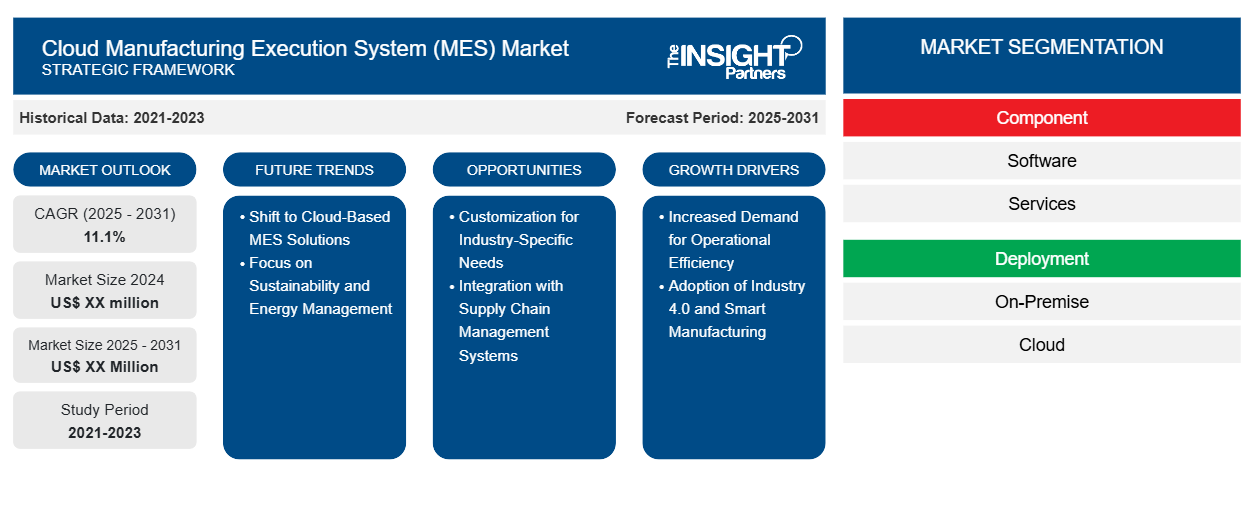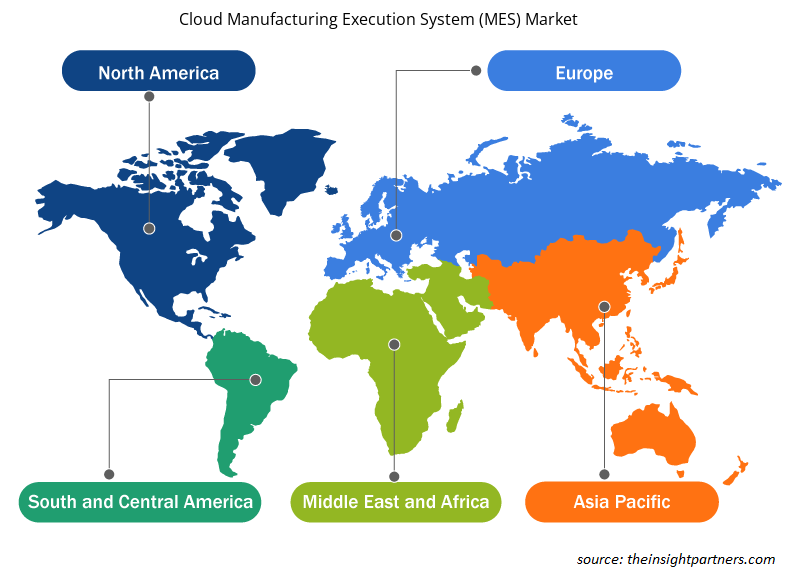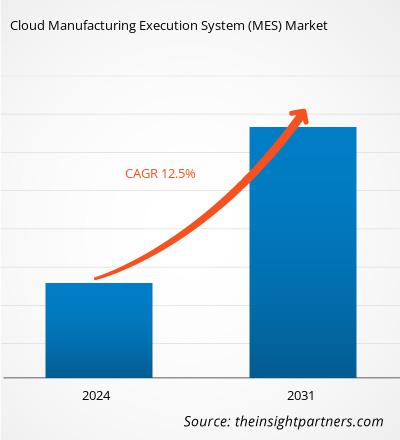Der Markt für Cloud Manufacturing Execution System (MES) wird voraussichtlich von 10,64 Milliarden US-Dollar im Jahr 2024 auf 24,13 Milliarden US-Dollar im Jahr 2031 anwachsen. Für den Zeitraum 2025–2031 wird eine durchschnittliche jährliche Wachstumsrate (CAGR) von 12,5 % erwartet. Die zunehmende Integration der Digital-Twin-Technologie dürfte in den kommenden Jahren neue Trends im Markt mit sich bringen.
Marktanalyse für Cloud Manufacturing Execution System (MES)
Die steigende Nachfrage nach kostengünstigen MES-Lösungen ist einer der Haupttreiber des Marktwachstums. Cloud-MES-Lösungen sind häufig auf Abonnementbasis erhältlich, sodass Hersteller die erforderlichen Rechenressourcen und Softwarelizenzen erhalten, ohne in ihre IT-Infrastruktur investieren zu müssen. Die Integration von Cloud-MES- und Industrie-4.0-Technologien transformiert die Fertigungsbranche, da sie Echtzeit-Konnektivität, verbesserte Analysen, vorausschauende Wartung und verstärkte Automatisierung ermöglicht. Da Cloud-MES-Systeme flexible Anpassungsmöglichkeiten bieten, wird ihre Nachfrage in den kommenden Jahren voraussichtlich steigen. Da Hybrid-Cloud-MES-Lösungen zudem die Übertragung unkritischer Daten in die Cloud ermöglichen, während kritische Fertigungsfunktionen sicher vor Ort verbleiben, wird die Verbreitung von Hybrid-Cloud-MES-Lösungen im Prognosezeitraum voraussichtlich zunehmen. Darüber hinaus wird die Integration der Digital-Twin-Technologie in Cloud-MES-Lösungen voraussichtlich neue Trends auf dem Markt mit sich bringen.
Marktübersicht für Cloud Manufacturing Execution System (MES)
Ein cloudbasiertes Manufacturing Execution System (MES) ist eine hochmoderne Softwarelösung zur Verwaltung und Optimierung von Fertigungsabläufen mithilfe von Cloud-Technologie. Im Gegensatz zu herkömmlichen On-Premise-Systemen, die auf lokale Server und Infrastruktur angewiesen sind, nutzt ein cloudbasiertes MES Remote-Server, um Echtzeitdaten und erweiterte Analysen von jedem Ort mit Internetverbindung bereitzustellen. Dieses System dient als zentrale Schnittstelle für alle produktionsrelevanten Aufgaben wie Planung, Bestandsverwaltung, Qualitätskontrolle und Anlagenverfolgung. Cloud-MES-Software ist auf die reibungslose Interaktion mit anderen Unternehmenstechnologien wie ERP-Systemen ausgelegt und bietet eine einheitliche Plattform für die Verfolgung und Optimierung aller Phasen des Fertigungsprozesses. Der Hauptvorteil eines cloudbasierten MES liegt in seiner Flexibilität und Skalierbarkeit. Hersteller können die Systemfunktionen anpassen, um ihre Produktionsziele ohne hohe Vorlaufkosten zu erreichen. Abonnementbasierte Preismodelle machen diese Systeme zugänglicher, indem sie die finanziellen und technischen Kosten von On-Premise-Alternativen senken. Diese Kombination aus Zugänglichkeit, Integration und Skalierbarkeit macht cloudbasierte MES zu einem unverzichtbaren Werkzeug für Unternehmen, die ihre Produktionssysteme modernisieren möchten.ERP systems, to provide a unified platform for tracking and optimizing each stage of the manufacturing process. The main benefit of a cloud-based MES is its flexibility and scalability. Manufacturers can alter system capabilities to meet production objectives without incurring major upfront costs. Subscription-based pricing models make these systems more accessible by lowering the financial and technical costs associated with on-premise alternatives. This combination of accessibility, integration, and scalability makes cloud-based MES a crucial tool for enterprises looking to upgrade their production systems.
Passen Sie diesen Bericht Ihren Anforderungen an
Sie erhalten kostenlos Anpassungen an jedem Bericht, einschließlich Teilen dieses Berichts oder einer Analyse auf Länderebene, eines Excel-Datenpakets sowie tolle Angebote und Rabatte für Start-ups und Universitäten
Markt für Cloud Manufacturing Execution System (MES): Strategische Einblicke

-
Informieren Sie sich über die wichtigsten Markttrends in diesem Bericht.Dieses KOSTENLOSE Beispiel umfasst Datenanalysen, von Markttrends bis hin zu Schätzungen und Prognosen.
Markttreiber und Chancen für Cloud Manufacturing Execution System (MES)
Integration mit Industrie 4.0
Die Integration von Industrie 4.0 und Cloud-MES markiert einen bedeutenden Wandel in der Fertigungsbranche. Industrie 4.0 nutzt Spitzentechnologien wie das Internet der Dinge (IoT), künstliche Intelligenz (KI), Big Data Analytics und intelligente Automatisierung, um intelligente, vernetzte Produktionsumgebungen zu schaffen. Cloud-MES fungiert als Kanal für den Echtzeit-Datenaustausch zwischen Fertigung und übergeordneten Unternehmenssystemen. Diese Fähigkeit ist im Kontext von Industrie 4.0 entscheidend, da schnelle und zuverlässige Daten für die Entscheidungsfindung benötigt werden. Durch die Kombination von Cloud-MES und IoT-Geräten erhalten Hersteller eine ganzheitliche Perspektive auf den Fertigungsprozess und können so Engpässe erkennen, den Anlagenzustand überwachen und die Ressourcennutzung optimieren.IoT), artificial intelligence (AI), big data analytics, and smart automation to build intelligent, interconnected production environments. Cloud MES acts as a channel for real-time data interchange between shop floors and higher-level corporate systems. This skill is critical in the context of Industry 4.0, where rapid and reliable data is required for decision-making. By combining cloud MES and IoT devices, manufacturers receive a holistic perspective of the manufacturing process, allowing them to spot bottlenecks, monitor equipment health, and improve resource utilization.
In Kombination mit IoT-Sensoren und KI-Algorithmen kann Cloud-MES Anlagenausfälle erkennen, bevor sie auftreten. Diese proaktive Strategie reduziert Ausfallzeiten, erhöht die Lebensdauer von Maschinen und senkt die Wartungskosten. Industrie 4.0 und Cloud-MES spielen eine wichtige Rolle im Qualitätsmanagement, indem sie verschiedene Faktoren während des gesamten Herstellungsprozesses überwachen und steuern. Durch die Integration mit fortschrittlicher Analytik und KI erkennt Cloud-MES mögliche Qualitätsprobleme frühzeitig im Fertigungszyklus, eliminiert Fehler und garantiert, dass nur Produkte, die den definierten Anforderungen entsprechen, auf den Markt gelangen. MES ermöglicht eine nahtlose Konnektivität mit Lieferanten, Händlern und anderen Lieferkettenpartnern. Diese Vernetzung erleichtert die Echtzeit-Zusammenarbeit, Bedarfsprognosen und das Bestandsmanagement und führt zu effizienteren und reaktionsschnelleren Lieferkettenabläufen. Die Kombination von Cloud-MES und Industrie-4.0-Technologien verändert die Arbeitsweise von Fabriken durch Echtzeit-Konnektivität, verbesserte Analytik, vorausschauende Wartung und erhöhte Automatisierung. Diese Funktionen ermöglichen es Herstellern, Produktionsprozesse zu optimieren, Kosten zu senken, die Qualität zu verbessern und die allgemeine Betriebseffizienz zu steigern. Mit der zunehmenden Verbreitung von Industrie 4.0-Technologien wird die Nachfrage nach Cloud-MES-Lösungen, die diese hochmodernen Fortschritte unterstützen, steigen und das Marktwachstum vorantreiben.IoT sensors and AI algorithms, cloud MES can identify equipment failures before they occur. This proactive strategy decreases downtime, increases the lifespan of machinery, and lowers maintenance expenses. Industry 4.0 and cloud MES play an important role in quality management by monitoring and managing various factors throughout the manufacturing process. Integration with advanced analytics and AI allows cloud MES to detect possible quality concerns early in the manufacturing cycle, eliminating faults and guaranteeing that only products that match defined requirements reach the market. MES allows for seamless connectivity with suppliers, distributors, and other supply chain partners. This interconnection facilitates real-time cooperation, demand forecasting, and inventory management, resulting in more efficient and responsive supply chain operations. The combination of cloud MES and Industry 4.0 technologies is transforming how factories operate by enabling real-time connectivity, improved analytics, predictive maintenance, and increased automation. These features allow manufacturers to streamline production processes, cut costs, improve quality, and boost overall operational efficiency. As Industry 4.0 technologies become more widely used, the demand for cloud MES solutions that support these cutting-edge advancements will increase, driving market growth.
Wachsende Nachfrage nach maßgeschneiderten Lösungen
Hersteller branchenübergreifend setzen zunehmend auf kundenorientierte Fertigungsstrategien, angetrieben durch die steigende Nachfrage nach maßgeschneiderten Produkten und kürzeren Lieferzeiten. Dieser Wandel erfordert MES-Lösungen, die hochgradig individualisierte Arbeitsabläufe, flexible Produktionspläne und dynamische Lieferkettenverbindungen ermöglichen. Cloud-MES-Systeme ermöglichen es Unternehmen, ihre Fertigungsprozesse an individuelle Kundenbedürfnisse anzupassen. Das System unterstützt bei der Konfiguration von Arbeitsabläufen und Berichtsfunktionen, um die spezifischen Anforderungen von Branchen wie der Automobil-, Luft- und Raumfahrt-, Lebensmittel- und Getränke- sowie Pharmaindustrie zu erfüllen. Darüber hinaus ermöglicht es die Skalierung der Anpassungsmöglichkeiten ohne kostspielige Infrastrukturinvestitionen. Beispielsweise benötigt ein Unternehmen, das individualisierte Medizinprodukte herstellt, möglicherweise eine MES-Lösung, die strenge Qualitätskontrollen, Chargenverfolgung und die Einhaltung von Gesundheitsvorschriften ermöglicht. Eine cloudbasierte MES-Plattform lässt sich leicht konfigurieren, um diese individuellen Anforderungen zu erfüllen.
Im Gegensatz zu herkömmlichen On-Premise-MES-Lösungen sind Cloud-MES-Plattformen anpassungsfähig und skalierbar, sodass Hersteller Funktionen und Features problemlos an ihre betrieblichen Anforderungen anpassen können. Diese Anpassungsfähigkeit ist wichtig für Hersteller in dynamischen Branchen wie der Elektronik- oder Konsumgüterindustrie, in denen sich Produktdesigns und Herstellungsprozesse regelmäßig ändern. Da KMU häufig über individuelle Produktionsmethoden und Ressourcenbeschränkungen verfügen, steigt die Nachfrage nach Cloud-MES-Systemen, da diese ihnen helfen, ihre spezifischen Anforderungen zu erfüllen, ohne dass hohe Anfangsinvestitionen in die IT-Infrastruktur erforderlich sind. Da Hersteller zunehmend nach flexibleren, skalierbaren und branchenspezifischen Lösungen suchen, die sich an ihre individuellen betrieblichen Anforderungen anpassen lassen, wird die Nachfrage nach Cloud-MES-Plattformen in Zukunft voraussichtlich steigen.
Segmentierungsanalyse des Marktberichts für Cloud Manufacturing Execution System (MES)
Schlüsselsegmente, die zur Ableitung der Marktanalyse für Cloud Manufacturing Execution System (MES) beigetragen haben, sind Typ und Endbenutzer.
- Basierend auf den Komponenten ist der Markt in Software und Service segmentiert. Der Markt für Serviceleistungen ist weiter in Professional Services und Managed Services unterteilt. Das Softwaresegment dominierte den Markt im Jahr 2024.
- Hinsichtlich der Bereitstellung ist der Markt in Private Cloud, Public Cloud und Hybrid Cloud segmentiert. Das Public-Cloud-Segment dominierte den Markt im Jahr 2024.
- Je nach Unternehmensgröße ist der Markt in kleine und mittlere Unternehmen sowie Großunternehmen segmentiert. Das Segment der Großunternehmen dominierte den Markt im Jahr 2024.
- Nach Vertriebskanälen wird der Markt in Direktvertrieb und Vertriebspartner unterteilt. Das Direktvertriebssegment dominierte den Markt im Jahr 2024.
- Der Markt ist nach Endverbrauchern in die Prozessindustrie und die diskrete Industrie segmentiert. Der Markt für die Prozessindustrie ist weiter unterteilt in Lebensmittel und Getränke, Öl und Gas, Chemie, Zellstoff und Papier, Chemie, Energie und Strom, Pharmazeutika und Biowissenschaften, Wasser- und Abwasseraufbereitung und Sonstiges. Der Markt für die diskrete Industrie ist weiter segmentiert in Automobil, Elektronik, Halbleiter, Luft- und Raumfahrt und Verteidigung, Konsumgüter, Medizinprodukte und Sonstiges. Das Segment der diskreten Industrie dominierte den Markt im Jahr 2024.
- Je nach Überwachungstyp ist der Markt für Cloud Manufacturing Execution System (MES) in Echtzeit-Temperaturüberwachung, Energiemanagement, Produktfrischeüberwachung, Datenprotokollierung und -analyse und weitere Bereiche unterteilt. Das Segment der Echtzeit-Temperaturüberwachung dominierte den Markt im Jahr 2024.
Cloud Manufacturing Execution System (MES) Marktanteilsanalyse nach Geografie
Der Markt für Cloud Manufacturing Execution System (MES) ist in fünf Hauptregionen unterteilt: Nordamerika, Europa, Asien-Pazifik (APAC), Naher Osten und Afrika (MEA) sowie Süd- und Mittelamerika.
Die USA, Kanada und Mexiko gehören zu den wichtigsten Ländern Nordamerikas. Die Region ist Vorreiter bei der Einführung von MES 4.0, das sich durch die Integration von Industrie-4.0-Technologien wie IoT, KI, maschinellem Lernen und Advanced Analytics auszeichnet. Der Trend zu MES 4.0 wird vor allem durch den Bedarf an intelligenteren, effizienteren Fertigungsabläufen, Echtzeitdaten und nahtloser Konnektivität zwischen Fertigung und Unternehmenssystemen vorangetrieben. Da sich die Industrie zunehmend auf die digitale Transformation konzentriert, bietet MES 4.0 die Infrastruktur für intelligente Fertigung und ermöglicht Echtzeit-Entscheidungen, vorausschauende Wartung und mehr Produktionsflexibilität. Sepasoft bietet MES 4.0 und eine Reihe von Tools, die Continuous Integration und Continuous Deployment (CI/CD) optimieren, Leistung und Stabilität verbessern und einen zukunftssicheren Betrieb unterstützen. Die Changeset-Funktion ermöglicht volle Kontrolle über die MES-Bereitstellung, während die Kompatibilität mit Ignition 8.3 leistungsstarke neue Funktionen wie Event Streams freischaltet.
Branchen in ganz Nordamerika setzen zunehmend auf Cloud-MES-Lösungen, um den Papierverbrauch zu reduzieren, die Dokumentenspeicherung zu vereinfachen, fehleranfällige Prozesse zu eliminieren und den Datenzugriff sowie die Datenanalyse zu verbessern. Darüber hinaus entwickeln die Marktteilnehmer in der Region kontinuierlich Innovationen, um ihren Kunden fortschrittlichere Lösungen anzubieten. So hat Tulip beispielsweise im Dezember 2022 sein Cloud Manufacturing Execution System (MES) in der Amazon Web Services (AWS) Solutions Library eingeführt und bietet Unternehmen eine kostengünstige, skalierbare MES-Lösung. Mit der zusammensetzbaren Plattform von Tulip und dem Echtzeit-Datenzugriff und der Zuverlässigkeit von AWS können Unternehmen ihre Betriebsabläufe mit einem Cloud-basierten MES transformieren.
Regionale Einblicke in den Cloud Manufacturing Execution System (MES)-Markt
Die Analysten von Insight Partners haben die regionalen Trends und Faktoren, die den Markt für Cloud Manufacturing Execution System (MES) im Prognosezeitraum beeinflussen, ausführlich erläutert. Dieser Abschnitt behandelt außerdem die Marktsegmente und die geografische Lage von Cloud Manufacturing Execution System (MES) in Nordamerika, Europa, Asien-Pazifik, dem Nahen Osten und Afrika sowie Süd- und Mittelamerika.

- Erhalten Sie regionale Daten zum Cloud Manufacturing Execution System (MES)-Markt
Umfang des Marktberichts zum Cloud Manufacturing Execution System (MES)
| Berichtsattribut | Details |
|---|---|
| Marktgröße im Jahr 2024 | 10,64 Milliarden US-Dollar |
| Marktgröße bis 2031 | 24,13 Milliarden US-Dollar |
| Globale CAGR (2025 – 2031) | 12,5 % |
| Historische Daten | 2021-2023 |
| Prognosezeitraum | 2025–2031 |
| Abgedeckte Segmente |
Nach Komponente
|
| Abgedeckte Regionen und Länder |
Nordamerika
|
| Marktführer und wichtige Unternehmensprofile |
|
Marktteilnehmerdichte für Cloud Manufacturing Execution System (MES): Auswirkungen auf die Geschäftsdynamik
Der Markt für Cloud Manufacturing Execution System (MES) wächst rasant. Die steigende Nachfrage der Endnutzer wird durch Faktoren wie veränderte Verbraucherpräferenzen, technologische Fortschritte und ein stärkeres Bewusstsein für die Produktvorteile angetrieben. Mit der steigenden Nachfrage erweitern Unternehmen ihr Angebot, entwickeln Innovationen, um den Bedürfnissen der Verbraucher gerecht zu werden, und nutzen neue Trends, was das Marktwachstum weiter ankurbelt.
Die Marktteilnehmerdichte beschreibt die Verteilung der in einem bestimmten Markt oder einer bestimmten Branche tätigen Unternehmen. Sie gibt an, wie viele Wettbewerber (Marktteilnehmer) in einem bestimmten Marktraum im Verhältnis zu dessen Größe oder Gesamtmarktwert präsent sind.
Die wichtigsten Unternehmen, die auf dem Markt für Cloud Manufacturing Execution System (MES) tätig sind, sind:
- Lehrling FS Inc
- 42Q
- SAP SE
- ABB Ltd
- Schneider Electric SE
- Infor
Haftungsausschluss : Die oben aufgeführten Unternehmen sind nicht in einer bestimmten Reihenfolge aufgeführt.

- Überblick über die wichtigsten Akteure auf dem Markt für Cloud Manufacturing Execution System (MES)
Marktnachrichten und aktuelle Entwicklungen zum Cloud Manufacturing Execution System (MES)
Der Markt für Cloud Manufacturing Execution System (MES) wird durch die Erhebung qualitativer und quantitativer Daten aus Primär- und Sekundärforschung bewertet, die wichtige Unternehmenspublikationen, Verbandsdaten und Datenbanken umfasst. Nachfolgend sind einige der Entwicklungen im Markt für Cloud Manufacturing Execution System (MES) aufgeführt:
- IBASET INC gab bekannt, dass Teledyne CML Composites, Großbritannien, sich für das Solumina Manufacturing Execution System und das Enterprise Quality Management System von iBase-t entschieden hat, um seine Fertigungsabläufe zu revolutionieren. Diese Partnerschaft ermöglicht es Teledyne, Möglichkeiten zur Kosten- und Zykluszeitreduzierung zu identifizieren und umzusetzen und gleichzeitig wichtige Herausforderungen bei der Einstellung und Schulung von Technikern zu bewältigen. (Quelle: IBASET INC, Pressemitteilung, Februar 2025)
- Honeywell hat seine Battery Manufacturing Excellence Platform (Battery MXP) vorgestellt, eine KI-gestützte Software, die den Betrieb von Gigafabriken vom ersten Tag an optimieren soll. Durch die Verbesserung der Batteriezellausbeute und die Beschleunigung der Anlageninbetriebnahme trägt sie dazu bei, die Materialausschussrate zu reduzieren, die bei herkömmlichen Lösungen bis zu 30 % betragen kann. Dies spart Energie- und Materialkosten bei der Skalierung der Produktion. (Quelle: Honeywell, Pressemitteilung, Juni 2024)
Marktbericht zum Cloud Manufacturing Execution System (MES): Umfang und Ergebnisse
Der Bericht „Marktgröße und Prognose für Cloud Manufacturing Execution System (MES) (2021–2031)“ bietet eine detaillierte Analyse des Marktes, die die unten genannten Bereiche abdeckt:
- Cloud Manufacturing Execution System (MES) Marktgröße und -prognose auf globaler, regionaler und Länderebene für alle wichtigen Marktsegmente, die im Rahmen des Berichts abgedeckt sind
- Markttrends für Cloud Manufacturing Execution System (MES) sowie Marktdynamiken wie Treiber, Einschränkungen und wichtige Chancen
- Detaillierte PEST- und SWOT-Analyse
- Marktanalyse für Cloud Manufacturing Execution System (MES), die wichtige Markttrends, globale und regionale Rahmenbedingungen, wichtige Akteure, Vorschriften und aktuelle Marktentwicklungen umfasst
- Branchenlandschafts- und Wettbewerbsanalyse mit Marktkonzentration, Heatmap-Analyse, prominenten Akteuren und jüngsten Entwicklungen für den Markt für Cloud Manufacturing Execution System (MES)
- Detaillierte Firmenprofile
- Historische Analyse (2 Jahre), Basisjahr, Prognose (7 Jahre) mit CAGR
- PEST- und SWOT-Analyse
- Marktgröße Wert/Volumen – Global, Regional, Land
- Branchen- und Wettbewerbslandschaft
- Excel-Datensatz
Aktuelle Berichte
Erfahrungsberichte
Grund zum Kauf
- Fundierte Entscheidungsfindung
- Marktdynamik verstehen
- Wettbewerbsanalyse
- Kundeneinblicke
- Marktprognosen
- Risikominimierung
- Strategische Planung
- Investitionsbegründung
- Identifizierung neuer Märkte
- Verbesserung von Marketingstrategien
- Steigerung der Betriebseffizienz
- Anpassung an regulatorische Trends






















 Kostenlose Probe anfordern für - Markt für Cloud Manufacturing Execution System (MES)
Kostenlose Probe anfordern für - Markt für Cloud Manufacturing Execution System (MES)